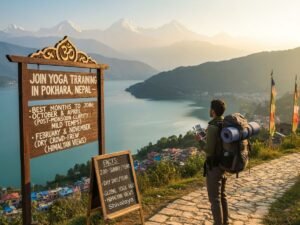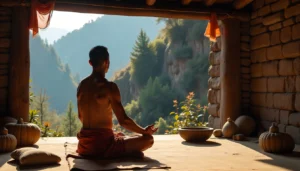Yoga has existed in our society for a long time and one of the great wise sages of yoga from ancient India was Maharshi Patanjali.
He was called as the father of yoga philosophy and not only that he also wrote the “Yoga Sutras” which tells you how you can control your body, mind, and find inner peace.
In his book he shared the 8 important steps of yoga which includes yoga philosophy, how to practice yoga, breathing exercise, meditation techniques and more.
What is Ashtanga Yoga?

The word “Ashtanga” itself is described in Sanskrit as “Ashta” means the number 8 and ”Anga” means body parts.
It includes practice simple things like being honest and kind (Yama), self care (Niyama), practicing physical postures (Asanas), breathing control (Pranayamas), calm your senses (Pratyahara), mind focus (Dharana), meditation (Dhyana), and lastly inner peace (Samadhi).
Fact: In the late 90s, Ashtanga yoga was considered one of the most widely practiced and popular yoga in the western countries.
The Eight Limbs of Yoga Overview:
1. Yama (Social Ethics / Moral Restraints)
Yama is the ethics concerning the interaction with others and society. This is the basis of spiritual living.
Ahimsa (Non-Violance):
Avoiding harm in words, actions and thoughts towards everyone including oneself.
- Satya (Truthfulness): Honesty is best policy as said speaking and living with honesty avoid lies and exaggerations.
- Asteya (Non-stealing): Asteya implies non-stealing, which means not taking something not freely given-Whether it be physical, emotional, or intellectual. It also means honoring the time and energy of others.
- Brahmacharya (Moderation / Celibacy): Brahmacharya implies moderation, or in extreme cases, celibacy; deal with sexual or sensual energy in a mindful way, a state that involves self-restraint, self-control, or moderation so that one has more vitality available for spiritual growth.
- Aparigraha (Non-possessiveness): Aparigraha means letting go- letting go of greed, attachment, and hoarding of materials. Trusting in abundance and living a simple life.
2. Niyama (Personal Ethics / Self-discipline)
Niyama teaches us observation for personal and spiritual growth concerning the ethics we have for ourselves. Therefore, this niyama observation is supposed to guide our behavior concerning oneself and the spiritual growth of the individual.
- Shaucha (Purity): Body, mind, and surroundings’ cleanliness. It includes healthy living, eating, and thinking.
- Santosha (Contentment): To allow oneself to settle for less. To train oneself in gratitude by accepting what is currently happening without making any conditional statements.
- Tapas (Discipline/Austerity): Willpower to overcome any problem where it is related to physical and emotional development and strong mental endurance.
- Svadhyaya (Self-study): This includes going within oneself and studying sacred texts or scriptures. It is knowing oneself through introspection and spiritual knowledge.
- Ishwarapranidhana (Surrender to the Divine): Ego loss and control letting go by giving oneself to any higher power or divine will. Growing trust and devotion.
3. Asana (Postures/Physical Discipline)
Asana by definition is “seat/posture” and implies all the physical positions in yoga, which evoke steadiness, strength, and comfort in the human body.
To create such a strong and steady body so that the person can sit without any discomfort or restlessness while meditating.
Quote: “Sthira Sukham Asanam” – Yoga Sutra 2.46
Importance:
- Build strength, balance, and flexibility in body
- Reduce physical tension
- Healthy pain free body with focused mind
4. Pranayama (Breath Control)
The word Pranayama itself is described in Sanskrit as life force & control meaning the continuous regulation of breathing and making balance in the inner body.
The purpose of this limb is to maintain the balance of energy in the human body, mind calmness, controlled breathing and many more.
Different Types of Pranayama:
- Nidhi shodhana which balances the left and right body energy channels
- Bhramari uses a gentle calming sound which calms the inner body systems.
- Anulom Vilom, Kapalabhati, and more are also types which have its own benefits
5. Pratyahara (Retraction of the Senses)
The purpose of Pratyahara is to withdraw yourself from external distractions just like a tortoise pulls in his limbs inside his shell.
Quote: “Sva vishaya asamprayoge chittasya svarupanukara iva indriyanam pratyaharah” (Yoga Sutra 2.54)
Importance:
- Helps detached form external distractions
- Bring self control over mind and body
- Prepares the mind and body for meditation and yoga
- Reduce stress over unnecessary things
6. Dharana (Concentration):
It is one of the most important limbs of patanjali yoga because it consists of pure concentration over mind and body. Dharana means focusing on one thing at a time so that you do not get distracted by other things.
It can also be your breathing, a mantra (some sounds you repeat), or even your third eye(between your eyebrows).
The importance of dharana is when you are able to concentrate on one thing you will build a strong mind and body connection and improve your mental ability.
7. Dhyana (Meditation):
Dhyana described as meditation, a state where your body and mind are in a fixed position and focusing without wandering.
It is like that your body is fully present and your mind is at peace from inside.
Importance:
- You will find deep inner peace
- Self awareness
- Emotional balance between your mind and body
- Reduces stress
- Improved sleep cycle
- Physical activeness and more.
8. Samadhi (Spiritual Absorption / Bliss):
Samadhi, which is the final stage of yoga where you become one with the help of meditation. Your mind, body and soul become one and merge into deep peace.
Why This is Important:
- The final goal of yoga
- Self realization
- Inner bliss and complete freedom
Difference Between Patanjali Ashtanga Yoga And Modern Ashtanga Vinyasa Yoga
| Limbs | Ashtanga Yoga | Modern Ashtanga Vinyasa Yoga | Sanskrit Quote (Yoga Sutra) |
|---|---|---|---|
| Yama | Kindness, honesty, integrity, self-control, detachment. | Not frequently discussed but practiced in most sessions. | “Ahimsā satya asteya brahmacharya aparigrahāḥ yamāḥ” (2.30) |
| Niyama | Purity, satisfaction, determination, reflection, trust in the divine. | Rarely emphasized; focus is more physical. | “Shaucha santosha tapah svādhyāya īshvara pranidhānāni niyamāḥ” (2.32) |
| Asana | Means of achieving stability and comfort in the body. | Physically intense and highly structured in terms of practice. | “Sthira sukham āsanam” (2.46) |
| Pranayama | Control of life force through breath. Leads to mental focus. | Present, but usually after asanas or in advanced practice. | “Tasmīn sati śvāsa praśvāsayoḥ gati vicchedaḥ prāṇāyāmaḥ” (2.49) |
| Pratyahara | Key for meditation – detachment from external distractions. | Rarely taught formally. | “Svaviṣaya asaṁprayoge cittasya svarūpa anukāraḥ iva indriyāṇām pratyāhāraḥ” (2.54) |
| Dharana | Builds mental stability, a precursor to meditation. | Not emphasized. | “Deśa bandhaḥ cittasya dhāraṇā” (3.1) |
| Dhyana | Continuous flow of awareness. | Not typically part of physical class. | “Tatra pratyaya ekatānatā dhyānam” (3.2) |
| Samadhi | Goal of yoga: liberation from ego and suffering. | Not a goal in modern physical practice. | “Tadeva arthamātra nirbhāsam svarūpa śūnyam iva samādhiḥ” (3.3) |
Conclusion
The 8 limbs of yoga explains how you can control your body, mind, and soul completely. If you are able to follow 1 or 2 limbs on a daily basis you will significantly see the progress inside your body both physically and mentally.
The eight limbs of yoga as described in Yoga Sutra provides a meaningful way of living your purposeful life. Applying these 8 limbs further enhances your decision making process, makes you a self disciplined person and helps you evolve in the best way possible.
FAQs:
Where can I learn the 8 limbs of yoga?
There are various ways you can learn like, you can learn from any online resource but to fully grasp the knowledge of 8 limbs you can sign up at any yoga studio.
What are the benefits of eight limbs of patanjali yoga?
There are numerous benefits of this, if you practice any one of the limbs on a regular basis you will exponentially see the growth inside your body.
How can someone practice these yoga variations?
Just follow the steps written in the book, online resource, or wherever and copy the exact same thing as written.
What beyond the 8 limbs?
Beyond this there is Kaivalya (liberation), a state of complete freedom.
Is it necessary to learn about the 8 limbs of yoga?
It is not completely necessary to learn but many people are doing it without realizing it, like doing asanas, meditations, pranayamas and more.





